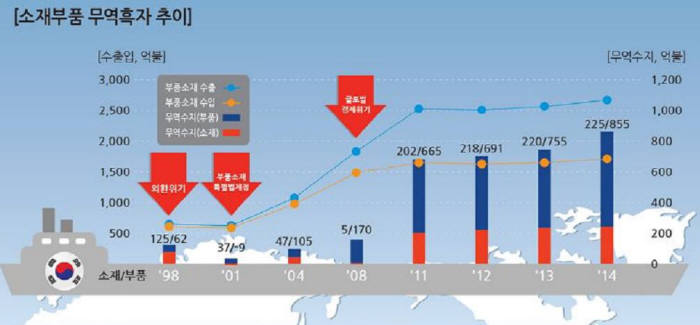Last year the trade surplus of materials and components amounted to $107.9 billion, the highest figure in history. It was pointed out that efforts to reduce Korea`s trade deficits with Japan must be continued and the competitiveness of the materials sectors needs to be improved.

According to the Ministry of Trade, Industry & Energy on January 8, last year Korea`s exports and imports of materials and components rose by 4.9% and 1.6% respectively over the previous year to $276 billion and $168.1 billion. The trade surplus amounted to $107.9 billion, exceeding $100 billion for the first time in history.
In 17 years after the domestic materials and components industry got out of trade deficit in 1997 for the first time, the trade surplus reached the $100 billion. It indicates that our economic growth paradigm shifted from assembly to materials and components and there has been a radical reform. Last year materials and components accounted for 48% of total exports. The trade surplus of materials and components was more than double the total surplus of $47.4 billion.
By region, China is firmly established as the largest market. The largest portion of the trade surplus of our materials and components industry comes from China ($46.9 billion), and China is our biggest trading partner ($143.7 billion).
The chronic trade deficit with Japan is gradually improving. The materials and components industry`s trade deficit with Japan was reduced from $24.3 billion in 2010 to $16.3 billion last year. Korea`s dependency on imports from Japan was 18.1% last year, a record low. For the materials and components industry to take another leap forward, the key is to continuously reduce our trade deficit with Japan, the only country with which Korea is recording a trade deficit.
Another task facing us is to enhance the competitiveness of the materials segment, which is regarded as the bottleneck of our manufacturing industry. The materials industry is advancing, but still inferior to the components segment. Components accounted for 79% of the trade surplus of the materials and components industry in 2014. Back in 2000, the trade surplus of components and materials was similar to each other at $4.9 billion and $4.4 billion respectively, but the gap has been widening since then. Last year the gap between the trade surplus of components and materials exceeded $60 billion.